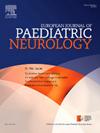儿童单纯疱疹病毒性脑炎的神经预后和残疾预测因素:来自法国三级医院的多中心队列研究
IF 2.3
3区 医学
Q3 CLINICAL NEUROLOGY
引用次数: 0
摘要
目的探讨影响儿童HSVE神经转归的相关因素。材料和方法在这项回顾性多中心观察性研究中,研究了HSVE患儿(≥28天,18岁)发病时的临床、临床旁数据和最后随访时的神经学结局。进行单因素和多因素分析以确定与神经预后相关的因素。结果纳入49例儿童,平均年龄4.9±5.5岁。最后随访5.9±3.13年,2例死亡(4%),37例(76%)出现神经系统预后不良,包括癫痫(57%)、智力障碍(51%)和语言障碍(47%)。76%的学生需要康复治疗,59%的学生学业成绩异常。发病时,年龄较小和癫痫发作与语言障碍显著相关(p <;在单变量分析中,运动障碍(p = 0.01)和智力障碍(p = 0.01)。mri异常在神经后遗症患儿中更为常见(p = 0.01)。多因素分析表明:(1)女性癫痫发生率更高(p = 0.03),并伴有岛叶病变(p = 0.048);(2)起病时有癫痫发作的患儿语言障碍发生率较高(p < 0.02);(3)低龄儿童运动障碍发生率较高(p = 0.03),丘脑病变发生率较高(p = 0.04)。结论我们的研究结果表明,尽管死亡率下降,但HSVE儿童的神经功能障碍水平仍然很高。这强调了加强HSVE管理策略的必要性。此外,已确定的与神经预后不良相关的风险因素可以帮助识别高危儿童,促进替代治疗方法的实施,如免疫治疗或强化康复。本文章由计算机程序翻译,如有差异,请以英文原文为准。
Neurological outcomes and disability predictors in paediatric herpes simplex virus encephalitis: a multicentre cohort from French tertiary hospitals
Objective
To identify factors associated with the neurological outcome of HSVE in children.
Materials and methods
In this retrospective multicentric observational study, clinical, paraclinical data at onset and neurological outcomes at last follow-up of children (≥28 days and <18 years old) with HSVE, were studied. Univariate and multivariate analyses were performed to identify factors associated with neurological outcome.
Results
49 children (mean age of 4.9 ± 5.5 years) were included. At last follow-up of 5.9 ± 3,13 years, 2 children died (4 %) and 37 (76 %) children presented with poor neurological outcome with epilepsy (57 %), intellectual disability (51 %) and language disorders (47 %). Rehabilitation was necessary for 76 % and 59 % had abnormal academic performances. At onset, younger age and seizures were significantly associated to language disorders (p < 0.01), motor disabilities (p = 0.01), and intellectual disabilities (p = 0.01) in univariate analysis. Abnormal MRIs were more frequent in children with neurological sequalae (p = 0.01). Multivariate analyses identified that: (1) epilepsy occurred more frequently in females (p = 0.03), with insular lesions (p = 0.048); (2) language disorders were more common in children who had seizures at onset (p 0.02); (3) motor disorders were more frequent in younger children (p = 0.03) with thalamic lesions (p = 0.04).
Conclusion
Our findings indicate that despite decrease in mortality rates, neurological disabilities in children with HSVE still persist at high levels. This underscores the need to enhance HSVE management strategies. Moreover, the identified risk factors associated with poor neurological outcomes can aid in identifying high-risk children, facilitating the implementation of alternative treatment approaches such as immunotherapy or intensive rehabilitation.
求助全文
通过发布文献求助,成功后即可免费获取论文全文。
去求助
来源期刊
CiteScore
6.30
自引率
3.20%
发文量
115
审稿时长
81 days
期刊介绍:
The European Journal of Paediatric Neurology is the Official Journal of the European Paediatric Neurology Society, successor to the long-established European Federation of Child Neurology Societies.
Under the guidance of a prestigious International editorial board, this multi-disciplinary journal publishes exciting clinical and experimental research in this rapidly expanding field. High quality papers written by leading experts encompass all the major diseases including epilepsy, movement disorders, neuromuscular disorders, neurodegenerative disorders and intellectual disability.
Other exciting highlights include articles on brain imaging and neonatal neurology, and the publication of regularly updated tables relating to the main groups of disorders.

 求助内容:
求助内容: 应助结果提醒方式:
应助结果提醒方式:


